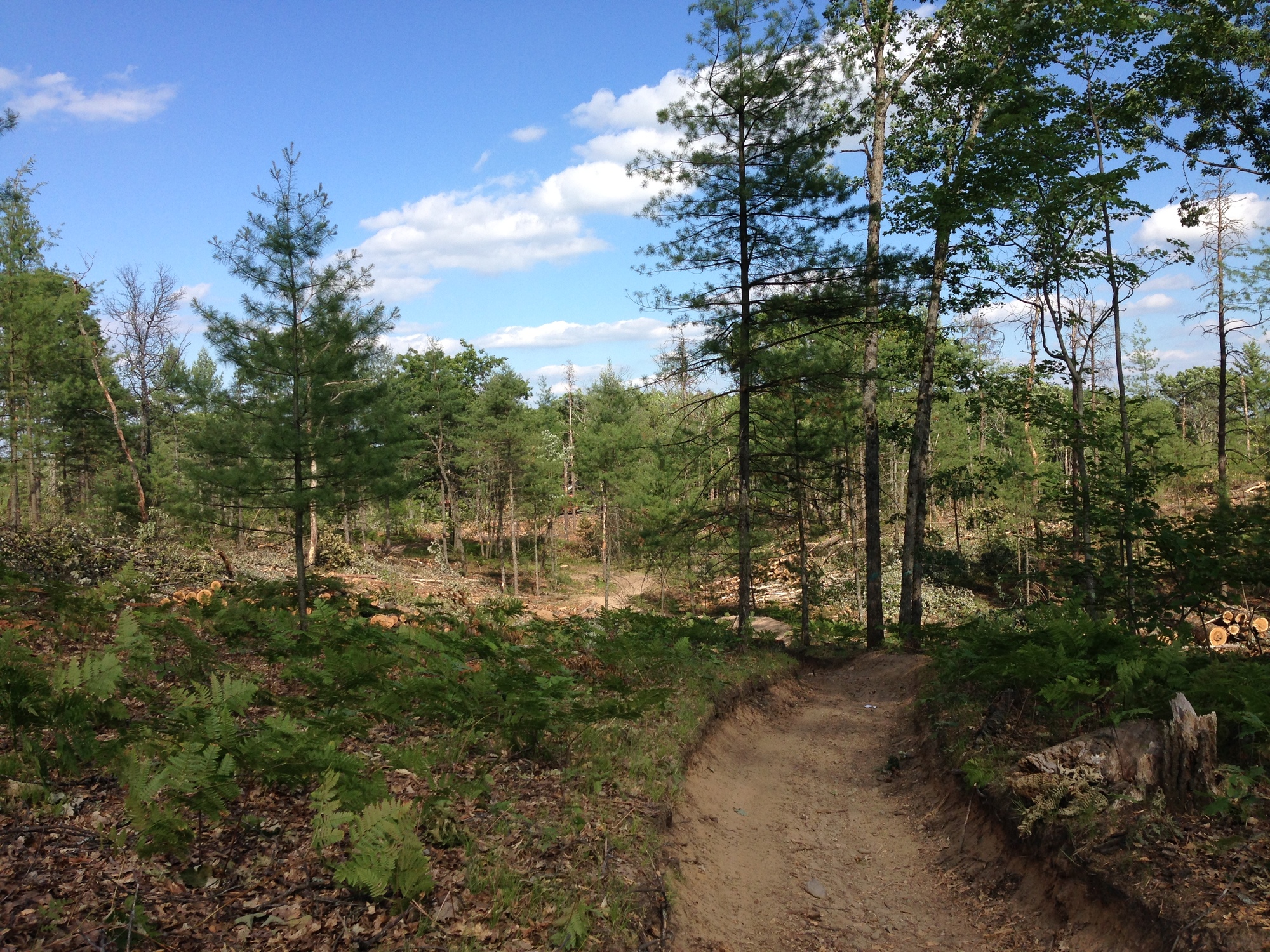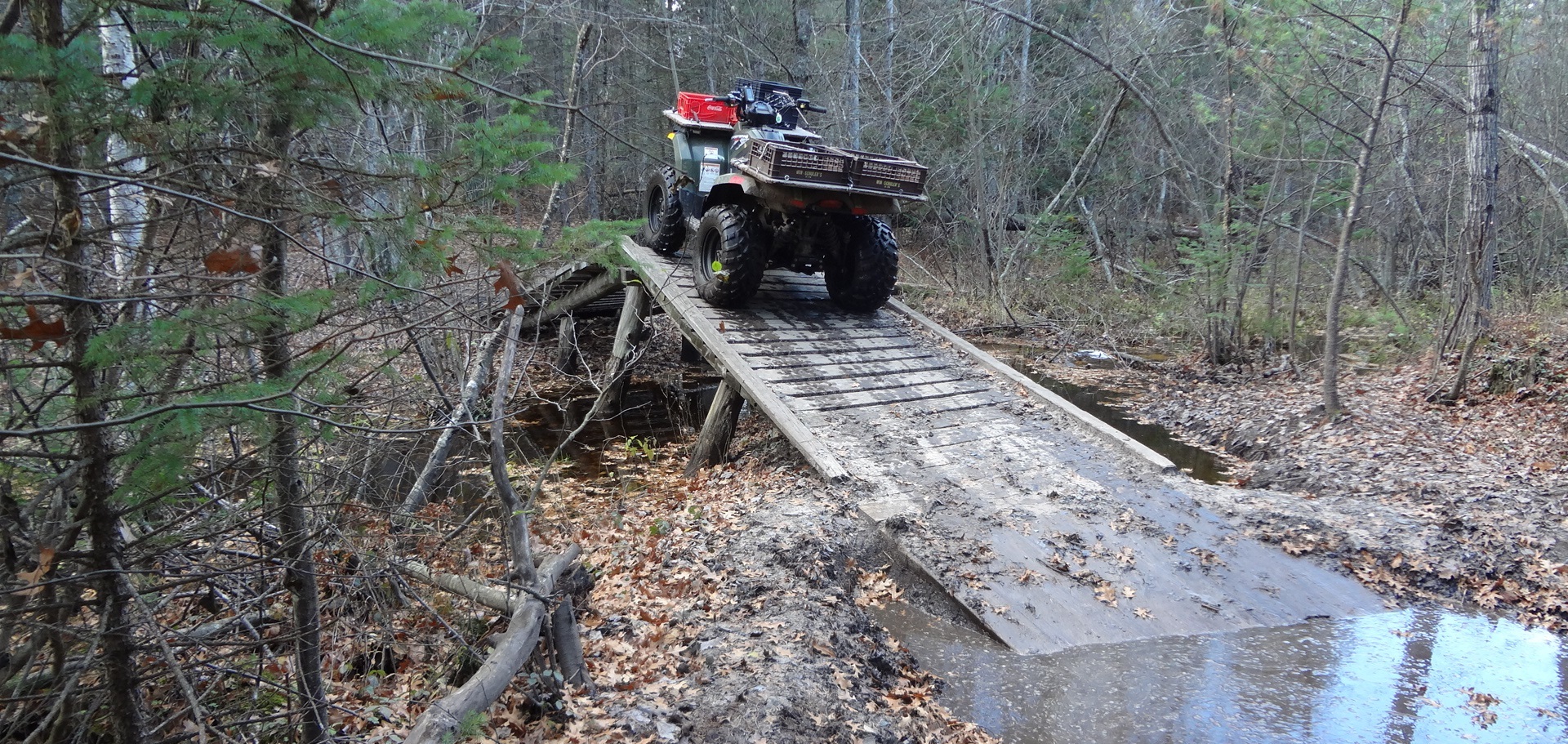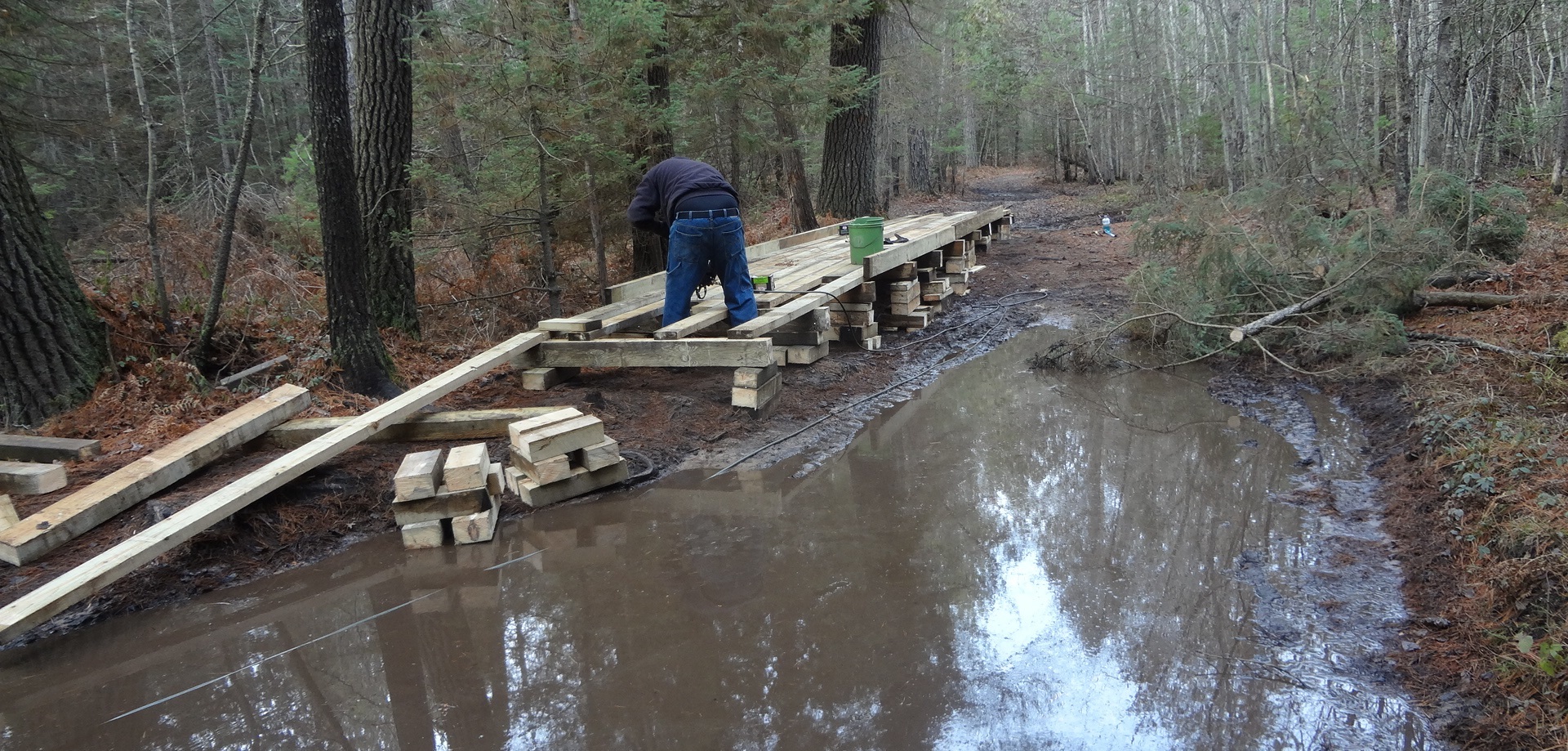Off-road vehicle riders see trail numerous network improvements in Lower Peninsula
DNR working to maintain trails, bridges and other features of ORV trail system
Those planning to ride the Lower Peninsula’s extensive network of off-road vehicle trails may want to pack a lunch, dinner and maybe a tent.
“The northern Lower Peninsula has nearly 3,425 miles of ORV trails,” said Emily Meyerson, DNR trail coordinator for the region.
For decades, the DNR and local trail groups have worked together to establish and strengthen the Lower Peninsula’s ORV trail system.
In recent months, more than a dozen projects have been completed or are under way to help restore and maintain trails, bridges, trailheads and other features.
This work was funded, in part, by ORV license fees.
The mix of off-road riding opportunities in the Lower Peninsula includes 1,160 miles of all-terrain vehicle (50-inch) trails, 1,588 miles of designated ORV routes, 1,285 miles of motorcycle trails and 391 miles of Michigan Cross Country Cycle Trail, which represents a combination of trail types.
In addition to these trails, Michigan has more than 1,300 miles of all-terrain vehicle, motorcycle and designated ORV routes in the Upper Peninsula.
Meyerson said that given the Lower Peninsula’s sprawling trails network, license fee revenue is being used to help keep the system in good shape.
“The focus has been primarily on maintenance and restoration, rather than strictly increasing miles of trail,” Meyerson said.
In Oceana County, four of the 15 projects or purchases have taken place at Silver Lake State Park – one of the premier attractions for Michigan ORV riders. In addition to repairing dunes, a parking lot and upgrading components of the park’s reservation system, a John Deere Gator XUV 825i was purchased.
The vehicle will allow additional access and faster response to emergency situations and maintenance needs for the park.
“Each year, over 500,000 vehicles travel through the park’s ORV area, which requires daily maintenance, and this vehicle will provide access,” Meyerson said. “Additionally, the Gator will provide transportation to check for full parking areas. This machine is also essential in maintaining good financial security as it provides easier access to booths where revenue is collected.”
 From bridge design work in Lake and Missaukee counties and trailhead improvements in Kalkaska County, washout and damage repairs in Wexford and Osceola counties to trail grading across three counties, these projects are helping to restore and maintain the Lower Peninsula’s important ORV trail system. From bridge design work in Lake and Missaukee counties and trailhead improvements in Kalkaska County, washout and damage repairs in Wexford and Osceola counties to trail grading across three counties, these projects are helping to restore and maintain the Lower Peninsula’s important ORV trail system.
In addition, there are 220 miles of ORV trails in the Cadillac District of the northern Lower Peninsula, located on lands managed by the U.S. Forest Service’s Huron-Manistee National Forest. Some of the recent ORV improvements occurred on these federal lands.
Beyond the restoration and maintenance projects, some new ORV routes have been built in the Lower Peninsula totaling 103 miles.
These new miles include the Indian Garden ORV Route and Trailhead, which winds for 38 miles in Emmet County, the West Higgins Lake ORV route, which stretches 36 miles through portions of Crawford, Missaukee and Kalkaska counties and the Old State House Trail and Route, which includes 4 miles in Iosco County.
There have also been various route connections constructed along the St. Helen ORV route totaling 21 miles in Roscommon and Ogemaw counties.
Billie Fancisco is the manager of Charlie’s Country Corner, a Marathon Gas travel center located just off the West Higgins ORV route in Crawford County.
She said the ORV trail is “extremely helpful” in benefitting local businesses in the area, including the travel center and a Super 8 motel situated nearby.
“We get lots of people here off of those ORV trails,” Francisco said.
These new trails improvement projects have arrived as ORV license and trail permit sales continue to climb in Michigan.
The number of ORV licenses purchased in the state climbed from 188,141 in 2007 to 206,755 in 2012. In 2014, with fee increases in place, riders purchased 196,695 ORV licenses and 127,740 trail permits.
The following year, those figures jumped to 207,957 licenses and 146,376 trail permits purchased. License and trail permit sales for this year are on a pace to surpass 2015.
Over the past few years, ORV access to trails has been provided for campers at five Michigan State Parks, including Clear Lake State Park in Montmorency County in the Lower Peninsula.
Dave Dekett, DNR unit manager at Clear Lake State Park, said since the land use order was adopted to accommodate access for ORV riders, the park at Clear Lake has become more popular.
“The park has as added a new ORV parking lot near the entrance for users who would like to just ride for the day and be able to enjoy the great outdoors,” Dekett said. “This growing (trail) system and increase in popularity has brought others from around the state to come up north.”
 Dekett said the Cycle Conservation Club of Michigan is an ORV group that has its annual “Rites of Spring” event at Clear Lakes State Park. Dekett said the Cycle Conservation Club of Michigan is an ORV group that has its annual “Rites of Spring” event at Clear Lakes State Park.
“This is a non-competitive event for all ages and many families have enjoyed using the ORV trails and camping out, creating those lifelong memories,” Dekett said. “There are many miles of trails that are accessible to area businesses and other campgrounds in the surrounding area.
“This makes a great opportunity for individuals and families who would like to enjoy the outdoors and explore new areas, and take in the beautiful scenery and observe the wildlife.”
The additional state parks allowing camps access to trails via ORVs are all located in the Upper Peninsula. They include Bewabic State Park in Iron County, Baraga State Park in Baraga County, Twin Lakes State Park in Houghton County and Muskallonge Lake State Park in Luce County.
Several groups throughout the northern Lower Peninsula and the rest of Michigan are working in concert with the DNR to improve opportunities for ORV riders and area businesses dependent on the sport.
The Cycle Conservation Club is among them.
“This group has worked on several of the deck projects in lowland areas,” said Todd Neiss, a DNR recreation specialist at the Cadillac office. “The work is critical to ensuring users stay on the trail and not create impact to the environment by creating ruts and creating a new trail around a water hole, damaging vegetation.”
Lewis Shuler, executive director of the club, said the group maintains 1,450 miles of trails and grades 2,100 miles, with work in both of Michigan’s peninsulas.
“We’re the ones that originally got the trails on the ground,” Shuler said. “We’ve been around since 1968. We’re across the state.”
As the popularity of off-road vehicles increases, so do the needs for trails and maintenance.
“We’d always like to see more trails and more maintenance and upkeep of what we do have,” Shuler said. “More money is needed for bridge repair or replacement across the state.”
License fee revenue will continue to be allocated for projects benefitting the ORV trails network throughout the state, including the Lower Peninsula’s extensive riding opportunities.
These improvements will be aimed at renovating and maintaining the ORV trails system now in place, as well as additional route development, further boosting Michigan’s growing reputation as the Trails State.
Check out more details on the 15 Lower Peninsula ORV projects or purchases.
Get more information on Michigan’s ORV trails network.
Catch upcoming stories by subscribing to free, weekly “Showcasing the DNR” articles. Check out previous Showcasing articles.
/Note to editors: Contact: Emily Meyerson 231-347-4899 or John Pepin 906-226-1352. Accompanying photos are available below for download and media use. Suggested captions follow. Credit: Michigan Department of Natural Resources, unless otherwise noted.
Basswood: The Basswood Restoration Project funded restoration on U.S. Forest Service-managed lands in the Lower Peninsula.
Bridge: Design was recently completed for replacing the dual use off-road vehicle/snowmobile Lincoln Bridge in Lake County.
Deck: Work is taking place in this photo to construct a deck over a watery area in the Lower Peninsula.
Geels: Decking along the Geels Trail in Roscommon County is among the improvements to the Lower Peninsula off-road vehicle trails network.
Trail: An all-terrain vehicle trail skirts a recent logging operation in the Ogemaw Hills Trail network.
Restoration: A dune restoration project at Silver Lake State Park in Oceana County was among more than a dozen Lower Michigan off-road vehicle-related improvements recently funded through license fees./
The Michigan Department of Natural Resources is committed to the conservation, protection, management, use and enjoyment of the state’s natural and cultural resources for current and future generations. For more information, go to www.michigan.gov/dnr.
|


 From bridge design work in Lake and Missaukee counties and trailhead improvements in Kalkaska County, washout and damage repairs in Wexford and Osceola counties to trail grading across three counties, these projects are helping to restore and maintain the Lower Peninsula’s important ORV trail system.
From bridge design work in Lake and Missaukee counties and trailhead improvements in Kalkaska County, washout and damage repairs in Wexford and Osceola counties to trail grading across three counties, these projects are helping to restore and maintain the Lower Peninsula’s important ORV trail system.
 Dekett said the Cycle Conservation Club of Michigan is an ORV group that has its annual “Rites of Spring” event at Clear Lakes State Park.
Dekett said the Cycle Conservation Club of Michigan is an ORV group that has its annual “Rites of Spring” event at Clear Lakes State Park.





